Weathering Mechanisms of Porous Marl Stones in Coastal Environments and Evaluation of Conservation Treatments as Potential Adaptation Action for Facing Climate Change Impact
Abstract
:1. Introduction
2. Materials and Methods
2.1. Seasonal Quantification of Salt Transition Events
2.2. Stone Samples and Conservation Materials
2.3. Conservation Products-Application Procedure
2.4. Physicochemical Characterization
2.5. Accelerating Aging Test
3. Results
3.1. Identification of Weathering Phenomena
3.2. Seasonal Quantification of Salt Transition Events
3.3. Mineralogical and Microstructural Characterization
3.4. Evaluation of Conservation Treatments
3.5. Durability against Salt Weathering
4. Discussion
5. Conclusions
- Both in situ and laboratory examination of the archaeological weathered stone samples of the Hellenistic theater of Zea highlighted water and soluble salts (NaCl) as the key parameters for the vulnerability of marly limestone.
- Past and current climate data indicated the continuous presence of an elevated number of annual crystallization events that maintain a very high risk for the natural stones of the Zea theater.
- The microstructural characteristics of the natural stone, such as the mesoporous structure characterized by low porous connectivity, contribute to the enhancement of the weathering phenomena, induced mainly by either the deposition of salts on the superficial layers or the absorption and circulation of water of high salt content inside the stone mass, enhanced by the microclimate conditions of the outdoor monument. The presence of swelling clays proved to increase the susceptibility of the marly limestone to water.
- In terms of adhesion, the two silane-based consolidants BS OH 100 and KSE 300HV present sufficient adhesion with the silicatic stone components, whereas the two water repellents FUNCOSIL SL and BS 1001 proved to form a non-continuous hydrophobic film in-between grains and inside the pores. The consolidant KSE 300HV and the two water repellents FUNCOSIL SL and BS 1001 proved to enhance the durability of the stone against salt weathering and to reduce the open porosity of the stone samples, improving the internal cohesion of the stone mass.
- Consolidation and hydrophobicity treatments proved to have a beneficial effect on the durability against salts crystallization, while the consolidant KSE 300HV and the two water repellents FUNCOSIL SL and BS 1001 exhibited the most promising results. The results suggested that a future in situ application of the conservation treatments should be implemented homogenously in order to avoid the presence of weathering phenomena induced on the untreated part of the stones.
Author Contributions
Funding
Institutional Review Board Statement
Informed Consent Statement
Data Availability Statement
Acknowledgments
Conflicts of Interest
References
- Bonomo, A.E.; Amodio, A.M.; Prossera, G.; Sileo, M.; Rizzo, G. Evaluation of soft limestone degradation in the Sassi UNESCO site (Matera, Southern Italy): Loss of material measurement and classification. J. Cult. Herit. 2020, 42, 191–201. [Google Scholar] [CrossRef]
- Grossi, C.M.; Brimblecombe, P.; Menéndez, B.; Benavente, D.; Harris, I.; Déqué, M. Climatology of salt transitions and implications for stone weathering. Sci. Total Environ. 2011, 409, 2577–2585. [Google Scholar] [CrossRef]
- Bonazza, A.; Messina, P.; Sabbioni, C.; Grossi, C.M.; Brimblecombe, P. Mapping the impact of climate change on surface recession of carbonate buildings in Europe. Sci. Total Environ. 2009, 407, 2039–2050. [Google Scholar] [CrossRef] [PubMed]
- Manohar, S.; Bala, K.; Santhanam, M.; Menon, A. Characteristics and deterioration mechanisms in coral stones used in a historical monument in a saline environment. Constr. Build. Mater. 2020, 241, 118102. [Google Scholar] [CrossRef]
- Anzani, A.; Cardani, G.; Condoleo, P.; Garavaglia, E.; Saisi, A.; Tedeschi, C.; Tibaroschi, C.; Valluzzi, M.R. Understanding of historical masonry for conservation approaches: The contribution of Prof. Luigia Binda to research advancement. Mater. Struct. Constr. 2018, 51, 1–27. [Google Scholar] [CrossRef]
- Apostolopoulou, M.; Keramidas, V.; Galanaki, N.; Kalofonou, M.; Skoula, C.; Karoglou, M.; Delegou, E.T.; Mouzakis, C.; Bakolas, A.; Moropoulou, A.; et al. A Study on the Historical Materials of the Apollo Pythios Temple in Rhodes and the Evaluation of Potential Restoration Materials. Heritage 2019, 2, 988–1022. [Google Scholar] [CrossRef] [Green Version]
- Ortiz, P.; Artunez, V.; Martin, J.M.; Ortiz, R.; Vasquez, M.A.; Galan, E. Approach to environmental risk analysis for the main monuments in a historical city. J. Cult. Herit. 2014, 15, 432–440. [Google Scholar] [CrossRef]
- Szczepaniak, M. Rock materials in monuments and archaeology–research methods. In Geoscience in Archaeometry. Methods and Case Studies; Michalska, D., Szczepaniak, M., Eds.; Bogucki Wydawnictwo Naukowe Publisher: Poznan, Poland, 2014; pp. 13–36. [Google Scholar]
- Patil, S.M.; Kasthurba, A.K.; Patil Mahesh, V. Characterization and assessment of stone deterioration on Heritage Buildings. Case Stud. Constr. Mater. 2021, 15, e00696. [Google Scholar] [CrossRef]
- Snethlage, R. Natural Stones in Architecture: Introduction. In Stone in Architecture Properties, Durability XII; Siegesmund, S., Snethlage, R., Eds.; Springer: Berlin/Heidelberg, Germany, 2011; Volume 552, pp. 1–9. [Google Scholar]
- Raju, K.; Ravindhar, S. Detailed review on natural stone materials in architecture. Mater. Today Proc. 2021, 45, 6341–6347. [Google Scholar] [CrossRef]
- Martínez-Martínez, J.; Arizzi, A.; Benavente, D. The Role of Calcite Dissolution and Halite Thermal Expansion as Secondary Salt Weathering Mechanisms of Calcite-Bearing Rocks in Marine Environments. Minerals 2021, 11, 911. [Google Scholar] [CrossRef]
- Caroll, P.; Aarrevaara, E. Review of Potential Risk Factors of Cultural Heritage Sites and Initial Modelling for Adaptation to Climate Change. Geosciences 2018, 8, 322. [Google Scholar] [CrossRef]
- Re, G.; Croce, A.; D’Angelo, D.; Marchese, L.; Rinaudo, C.; Gatti, G. Application of nano-coating technology for the protection of natural lapideous materials. Surf. Coat. Technol. 2022, 441, 128507. [Google Scholar] [CrossRef]
- Hatir, M.E.; Barstugari, M.; Incec, I. Deep learning-based weathering type recognition in historical stone monuments. J. Cult. Herit. 2020, 45, 193–203. [Google Scholar] [CrossRef]
- Sesana, E.; Gagnon, A.S.; Ciantelli, C.; Cassar, J.A.; Hughes, J.J. Climate change impacts on cultural heritage: A literature review. Clim. Change 2021, 12, e710. [Google Scholar] [CrossRef]
- Spezziano, P. Mapping the susceptibility of UNESCO World Cultural Heritage sites in Europe to ambient (outdoor) air pollution. Sci. Total Environ. 2021, 754, 142345. [Google Scholar] [CrossRef]
- Sardella, A.; Palazzi, E.; von Hardenberg, J.; Del Grande, C.; De Nuntiis, P.; Sabbioni, C.; Bonazza, A. Risk Mapping for the Sustainable Protection of Cultural Heritage in Extreme Changing Environments. Atmosphere 2020, 11, 700. [Google Scholar] [CrossRef]
- Theodoridou, M.; Török, A. In situ investigation of stone heritage sites for conservation purposes: A case study of the Székesfehérvár Ruin Garden in Hungary. Prog. Earth Planet. Sci. 2019, 6, 15. [Google Scholar] [CrossRef]
- Rodríguez-Rosales, B.; Abreu, D.; Ortiz, R.; Becerra, J.; Cepero-Acán, A.E.; Vázquez, M.A.; Ortiz, P. Risk and vulnerability assessment in coastal environments applied to heritage buildings in Havana (Cuba) and Cadiz (Spain). Sci. Total Environ. 2021, 750, 141617. [Google Scholar] [CrossRef]
- Gibeaux, S.; Vázquez, P.; De Kock, T.; Cnudde, V.; Thomachot-Schneider, C. Weathering assessment under X-ray tomography of building stones exposed to acid atmospheres at current pollution rate. Constr. Build. Mater. 2018, 168, 187–198. [Google Scholar] [CrossRef]
- Vecco, M.; Srakar, A. The unbearable sustainability of cultural heritage: An attempt to create an index of cultural heritage sustainability in conflict and war regions. J. Cult. Herit. 2018, 33, 293–302. [Google Scholar] [CrossRef]
- Patil, S.M.; Kasthurba, A.K. Weathering of stone monuments: Damage assessment of basalt and laterite. Mater. Today Proc. 2021, 43, 1647–1658. [Google Scholar] [CrossRef]
- Molina, E.; Cultrone, G.; Sebastián, E.; Alonso, F.J.; Carrizo, L.; Gisbert, J.; Buj, O. The pore system of sedimentary rocks as a key factor in the durability of building materials. Eng. Geol. 2011, 118, 110–121. [Google Scholar] [CrossRef]
- Cardell, C.; Delalieux, F.; Roumpopoulos, K.; Moropoulou, A.; Auger, F.; Van Grieken, R. Salt-induced decay in calcareous stone monuments and buildings in a marine environment in SW France. Constr. Build. Mater. 2003, 17, 165–179. [Google Scholar] [CrossRef]
- Michalopoulou, A.; Sioulas, D.; Amenta, M.; Kilikoglou, V.; Karatasios, I. Variable Weathering Response of Architectural Marlstones Against NaCl Crystallization. In 10th International Symposium on the Conservation of Monuments in the Mediterranean Basin. MONUBASIN 2017; Koui, M., Zezza, F., Kouis, D., Eds.; Springer: Berlin/Heidelberg, Germany, 2018; pp. 347–355. [Google Scholar] [CrossRef]
- Theoulakis, P.; Moropoulou, A. Microstructural and mechanical parameters determining the susceptibility of porous building stones to salt decay. Constr. Build. Mater. 1997, 11, 65–71. [Google Scholar] [CrossRef]
- Stefanis, N.A.; Theoulakis, P.; Pilinis, C. Dry deposition effect of marine aerosol to the building stone of the medieval city of Rhodes, Greece. Build. Environ. 2009, 44, 260–270. [Google Scholar] [CrossRef]
- Zezza, F.; Macri, F. Marinea erosol and stone decay. Sci. Total Environ. 1995, 167, 123–143. [Google Scholar] [CrossRef]
- Zornoza-Indart, A.; Lopez-Arce, P.; Zoghlami, K.; Leal, N.; Simão, J. Marine Aerosol Weathering of Mediterranean Calcarenite Stone: Durability of Ethyl Silicate, Nano Ca(OH)2, Nano SiO2, and Nanostructured Consolidating Products. Studi. Con. 2019, 64, 73–89. [Google Scholar] [CrossRef] [Green Version]
- Rodriguez-Navarro, C.; Doehne, E.; Sebastian, E. Origins of honeycomb weathering: The role of salts and wind. GSA Bull. 1999, 111, 1250–1255. [Google Scholar] [CrossRef]
- Lopez-Arce, P.; Garcia-Guinea, J.; Benavente, D.; Tormo, L.; Doehne, E. Deterioration of dolostone by magnesium sulphate salt: An example of incompatible building materials at Bonaval Monastery, Spain. Constr. Build. Mater. 2009, 23, 846–855. [Google Scholar] [CrossRef]
- Morillas, H.; Maguregui, M.; Gallego-Cartagena, E.; Marcaida, I.; Carral, N.; Madariaga, J.M. The influence of marine environment on the conservation state of Built Heritage: An overview study. Sci. Total Environ. 2020, 745, 140899. [Google Scholar] [CrossRef]
- Sirbu, R.; Negreanu-Pirjol, T.; Sirbu, M.; Cadar, E.M. Aggressivity of the marine medium in some buildings from the Romanian Black Sea coast. J. Environ. Prot. Ecol. 2006, 7, 59–68. [Google Scholar]
- Azeroual, M.; Baghdad, B.; Bounakhla, M.; Doukkali, A.; El Wartiti, M. The atmospheric pollution and the marine aerosols impact on the monumental stone of the Sale surrounding wall’s entrances (Morroco). Phys. Chem. News 2007, 33, 59–64. [Google Scholar]
- Costa, E.A.L.; Campos, V.P.; da Silva Filho, L.C.P.; Greven, H.A. Evaluation of the aggressive potential of marine chloride and sulfate salts on mortars applied as renders in the Metropolitan Region of Salvador-Bahia, Brazil. J. Environ. Manag. 2008, 90, 1060–1068. [Google Scholar] [CrossRef] [Green Version]
- Flatt, R.J. Salt damage in porous materials: How high supersaturations are generated. J. Cryst. Growth 2002, 242, 435–455. [Google Scholar] [CrossRef]
- Lubelli, B.; van Hees, R.P.J. Evaluation of the Effect of Nano-Coatings with Water Repellent Properties on the Absorption and Drying Behaviour of Brick IN Hydrophobe VI 6th International Conference on Water Repellent Treatment of Building Materials; Fassina, V., Ed.; Aedificatio Publishers: Rome, Italy, 2011; pp. 125–136. [Google Scholar]
- Steiger, M. Crystal growth in porous materials: I. The crystallization pressure of large crystals. J. Cryst. Growth 2005, 282, 455–469. [Google Scholar] [CrossRef]
- Zornoza-Indart, A.; Lopez-Arce, P. 3—Stone. In Long-Term Performance and Durability of Masonry Structures; Ghiassi, B., Lourenço, P.B., Eds.; Woodhead Publishing Series in Civil and Structural Engineering; Woodhead Publishing: Cambridge, UK, 2019; pp. 59–88. [Google Scholar] [CrossRef]
- Apostolopoulos, G.; Pavlopoulos, K.; Goiran, J.-P.; Fouache, E. Was the Piraeus peninsula (Greece) a rocky island? Detection of pre-Holocene rocky relief with borehole data and resistivity tomography analysis. J. Archaeol. Sci. 2014, 42, 412–421. [Google Scholar] [CrossRef]
- Goiran, J.-P.; Pavlopoulos, K.; Fouache, E.; Triantaphyllou, M.; Etienne, R. Piraeus, the ancient island of Athens: Evidence from Holocene sediments and historical archives. Geology 2011, 39, 531–534. [Google Scholar] [CrossRef]
- Cai, Y.; Hou, P.; Duan, C.; Zhang, R.; Zhou, Z.; Cheng, Z.; Shah, S. (The use of tetraethyl orthosilicate silane (TEOS) for surface-treatment of hardened cement-based materials: A comparison study with normal treatment agents. Constr. Build. Mater. 2016, 117, 144–151. [Google Scholar] [CrossRef]
- Adamopoulos, F.G.; Vouvoudi, E.C.; Pavlidou, E.; Achilias, D.S.; Karapanagiotis, I. TEOS-Based Superhydrophobic Coating for the Protection of Stone-Built Cultural Heritage. Coatings 2021, 11, 135. [Google Scholar] [CrossRef]
- Sena da Fonseca, B.; Ferreira Pinto, A.P.; Piçarra, S.; Montemor, M.F. Alkoxysilane-based sols for consolidation of carbonate stones: Proposal of methodology to support the design and development of new consolidants. J. Cult. Herit. 2020, 43, 51–63. [Google Scholar] [CrossRef]
- Briffa, S.M.; Vella, D.A. The behaviour of as-applied and artificially weathered silica–epoxy consolidants on a typical Mediterranean porous limestone: A comparison with TEOS. Herit. Sci. 2019, 7, 1–13. [Google Scholar] [CrossRef]
- Gemelli, G.M.C.; Zarzuela, R.; Alarcón-Castellano, F.; Mosquera, M.J.; Almoraima Gil, M.L. Alkoxysilane-based consolidation treatments: Laboratory and 3-years In-Situ assessment tests on biocalcarenite stone from Roman Theatre (Cádiz). Constr. Build. Mater. 2021, 312, 125398. [Google Scholar] [CrossRef]
- Ban, M.; De Kock, T.; Ott, F.; Barone, G.; Rohatsch, A.; Raneri, S. Neutron Radiography Study of Laboratory Ageing and Treatment Applications with Stone Consolidants. Nanomaterials 2019, 9, 635. [Google Scholar] [CrossRef] [PubMed] [Green Version]
- Ferreira Pinto, A.P.; Delgado Rodrigues, J. Impacts of consolidation procedures on colour and absorption kinetics of carbonate stones. Stud. Conserv. 2014, 59, 79–90. [Google Scholar] [CrossRef]
- Karatasios, I.; Michalopoulou, A.; Amenta, M.; Kilikoglou, V. Modification of water transport properties of porous building stones caused by polymerization of silicon-based consolidation products. Pure. Appl. Chem. 2017, 89, 1673–1684. [Google Scholar] [CrossRef]
- Nunes, C.; Aguilar Sanchez, A.N.; Godts, S.; Gulotta, D.; Ioannou, I.; Lubelli, B.; Menendez, B.; Shahidzadeh, N.; Slížková, Z.; Theodoridou, M. Experimental research on salt contamination procedures and methods for assessment of the salt distribution. Constr. Build. Mater. 2021, 298, 123862. [Google Scholar] [CrossRef]
- ICOMOS. Illustrated Glossary of Stone Deterioration Patterns; ICOMOS Open Archive: Petra, Jordan, 2001. [Google Scholar]
- Choquette, P.W.; Pray, L.C. Geologic Nomenclature and Classification of Porosity in Sedimentary Carbonates. AAPG Bull. 1970, 54, 207–250. [Google Scholar]
- Fournier, F.; Pellerin, M.; Villeneuve, Q.; Teillet, T.; Hong, F.; Poli, E.; Borgomano, J.; Léonide, P.; Hairabian, A. The Equivalent Pore Aspect Ratio as A Tool For Pore Type Prediction In Carbonate Reservoirs. AAPG Bull. 2018, 102, 1343–1377. [Google Scholar] [CrossRef]
- Verganelaki, A.; Kilikoglou, V.; Karatasios, I.; Maravelaki-Kalaitzaki, P. A biomimetic approach to strengthen and protect construction materials witha novel calcium-oxalate–silica nanocomposite. Constr. Build. Mat. 2014, 62, 8–17. [Google Scholar] [CrossRef]
- Bracciale, M.P.; Sammut, S.; Cassar, J.; Santarelli, M.L.; Marrocchi, A. Molecular Crystallization Inhibitors for Salt Damage Control in Porous Materials: An Overview. Molecules 2020, 25, 1873. [Google Scholar] [CrossRef] [Green Version]
- Granneman, S.J.C.; Lubelli, B.; van Hees, R.B.J. Mitigating salt damage in building materials by the use of crystallization modifiers—A review and outlook. J. Cult. Herit 2019, 40, 183–194. [Google Scholar] [CrossRef]
- Ferdyn-Grygierek, J.; Kaczmarczyk, J.M.; Blaszczok, J.M.; Lubina, P.; Koper, P.; Bulinska, A. Hygrothermal Risk in Museum Buildings Located in Moderate Climate. Energies 2020, 13, 344. [Google Scholar] [CrossRef] [Green Version]
- Bot, I.K.; Bousahla, A.A.; Zemri, A.; Sekkal, M.; Kaci, M.; Bourada, A.; Tounsi, F.; Ghazwani, M.H.; Mahmoud, S.R. Effects of Pasternak foundation on the bending behavior of FG porous plates in hygrothermal environment. Steel Compos. Struct. 2022, 43, 821–837. [Google Scholar]
- Cuong-Le, T.; Nguyen, K.D.; Hoang-Le, M.; Sang-To, T.; Phan-Vu, P.; Wahab, M.A. Nonlocal strain gradient IGA numerical solution for static bending, free vibration and buckling of sigmoid FG sandwich nanoplate. Phys. B Condens. Mat. 2022, 631, 413726. [Google Scholar] [CrossRef]
- Yao, S.; Yan, Z.; Ma, Q.; Xu, B.; Zhang, Z.; Bi, W.; Zhang, J. Analysis of the annual hygrothermal environment in the Maijishan Grottoes by field measurements and numerical simulations. Build. Environ. 2022, 221, 109229. [Google Scholar] [CrossRef]
- Martín-Garín, A.; Millán-García, J.A.; Terés-Zubiaga, J.; Oregi, X.; Rodríguez-Vidal, I.; Baïri, A. Improving Energy Performance of Historic Buildings through Hygrothermal Assessment of the Envelope. Buildings 2021, 11, 410. [Google Scholar] [CrossRef]
- Snethlage, R. Leitfaden Steinkonservierung, 2nd ed.; Fraunhofer IRB Verlag: Stuttgart, Germany, 2005. [Google Scholar]
- Benavente, D.; Sanchez-Moral, S.; Fernandez-Cortes, A.; Cavaneras, J.C.; Elez, J.; Saint-Jimenez, C. Salt damage and microclimate in the Postumius Tomb, Roman Necropolis of Carmona, Spain. Environ. Earth Sci. 2011, 63, 1529–1543. [Google Scholar] [CrossRef] [Green Version]
- Benavente, D.; Such-Basañez, I.; Fernandez-Cortes, A.; Pla, C.; Cazorla-Amoros, D.; Cañaveras, J.C.; Sanchez-Moral, J.C. Comparative analysis of water condensate porosity using mercury intrusion porosimetry and nitrogen and water adsorption techniques in porous building stones. Constr. Build. Mater. 2021, 288, 123131. [Google Scholar] [CrossRef]
- Tiennot, M.; Mertz, J.D.; Bourgès, A. Influence of clay minerals nature on the hydromechanical and fracture behaviour of Stones. Rock Mech. Rock Eng. 2019, 52, 1599–1611. [Google Scholar] [CrossRef] [Green Version]
- Michalopoulou, A.; Maravelaki, N.; Stefanis, N.A.; Theoulakis, P.; Andreou, S.; Kilikoglou, V.; Karatasios, I. Evaluation of nanolime dispersions for the protection of archaeological clay-based building materials. Mediterr. Archaeol. Archaeom. 2020, 20, 221–242. [Google Scholar] [CrossRef]
- Benavente, D.; García del Cura, M.A.; Bernabéu, A.; Ordóñez, S. Quantification of salt weathering in porous stones using an experimental continuous partial immersion method. Eng. Geol. 2001, 59, 313–325. [Google Scholar] [CrossRef]
- Ruffolo, S.A.; Ricca, M.; Macchia, A.; La Russa, M.F. Antifouling coatings for underwater archaeological stone materials. Prog. Org. Coat. 2017, 104, 64–71. [Google Scholar] [CrossRef]
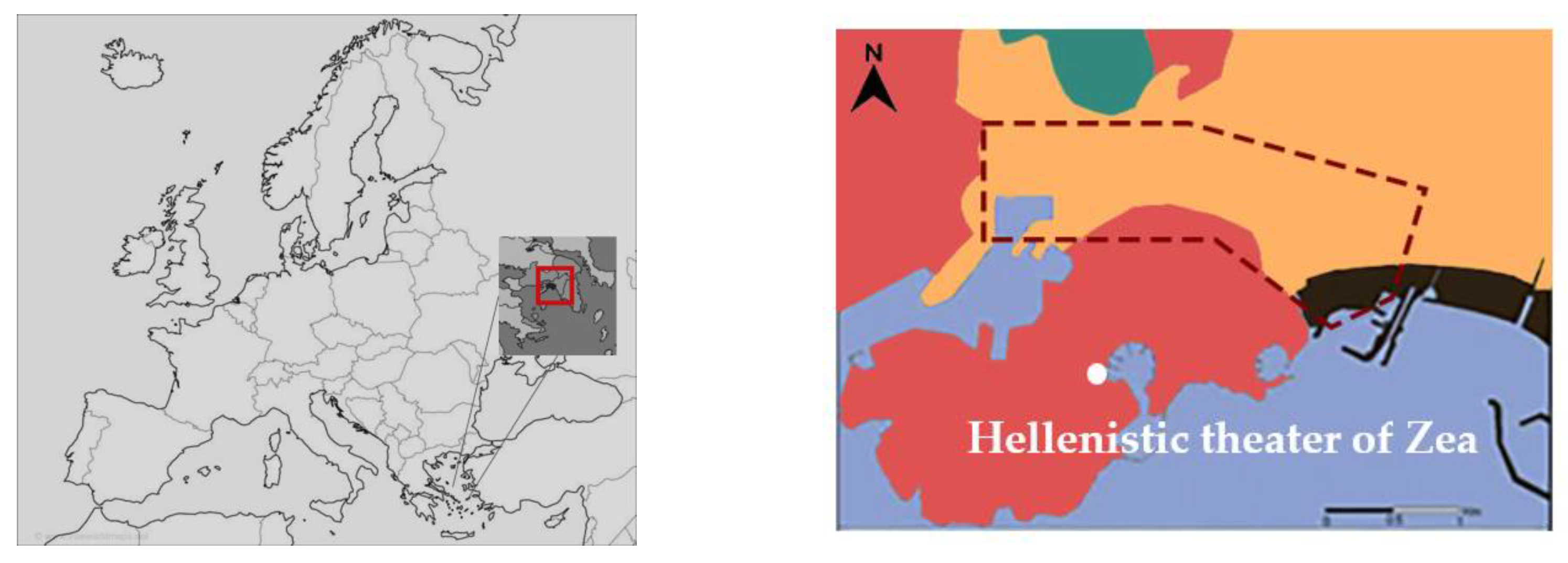
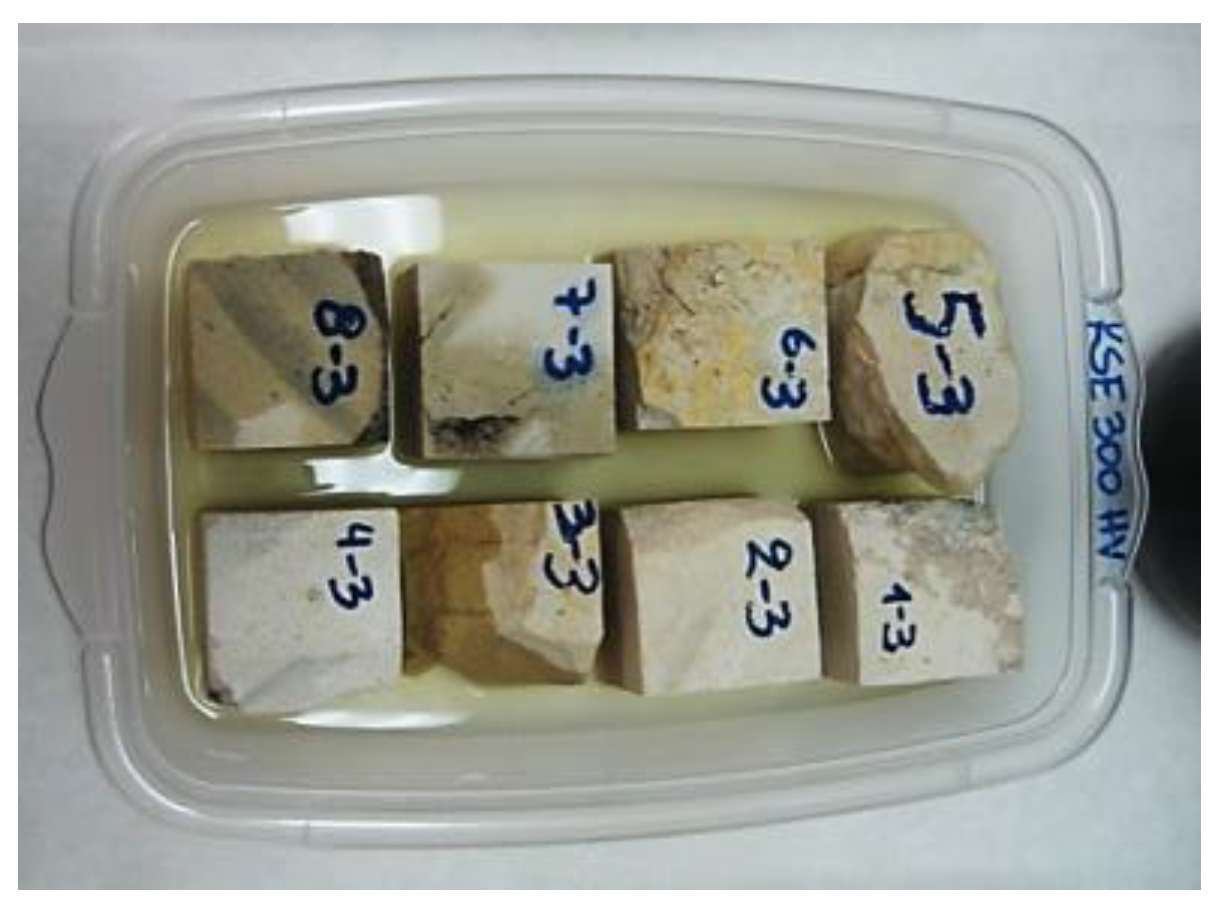

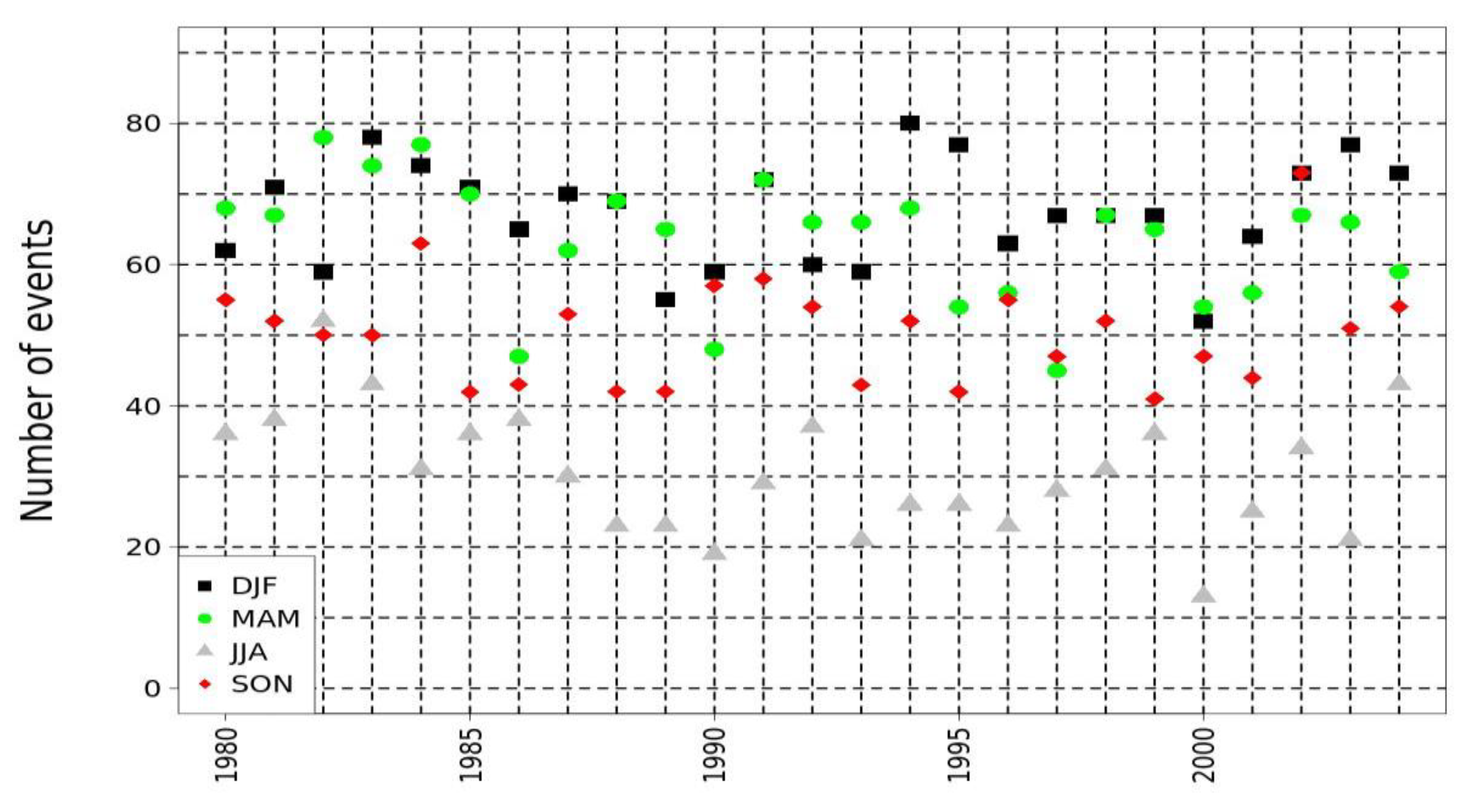



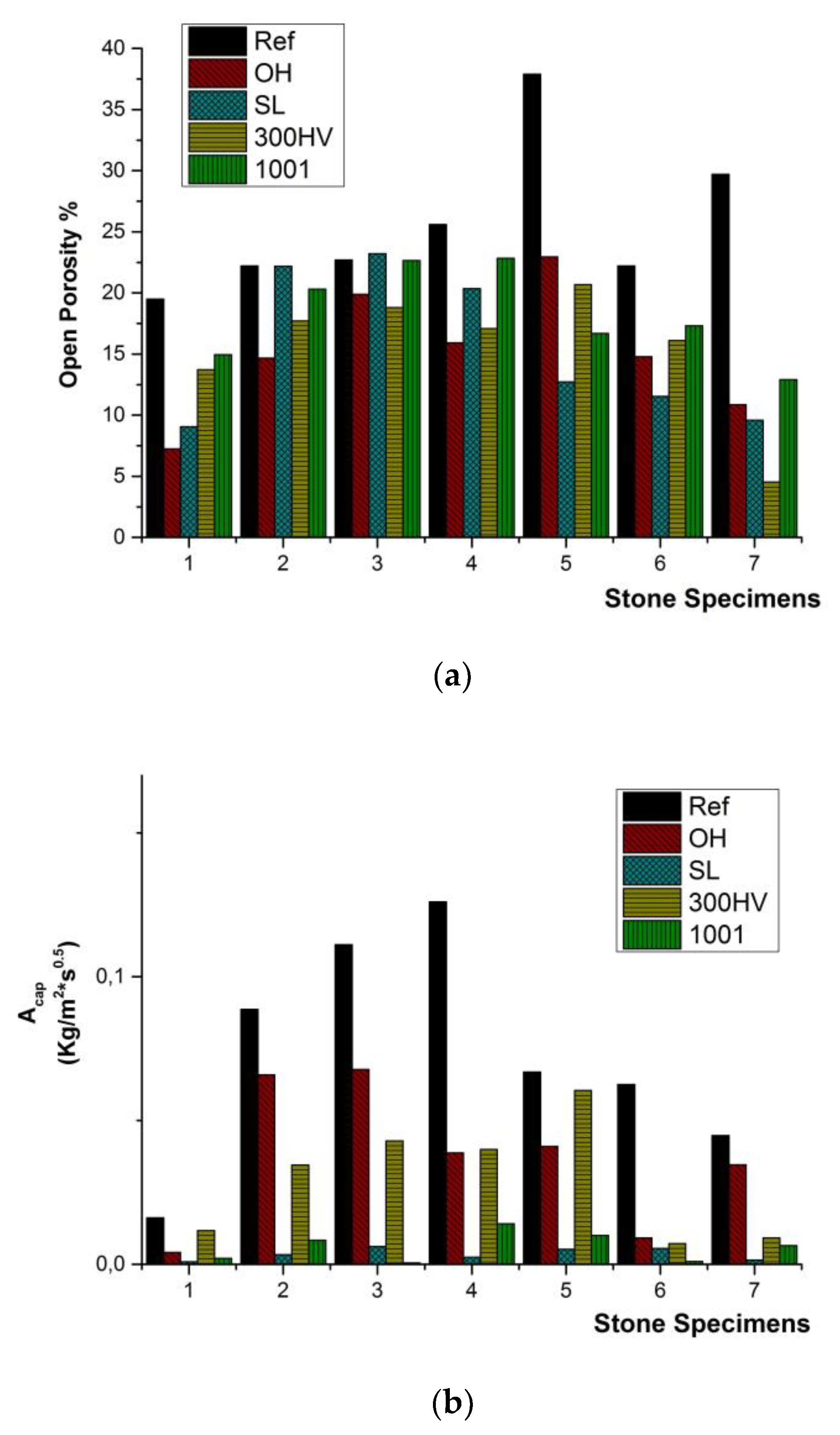
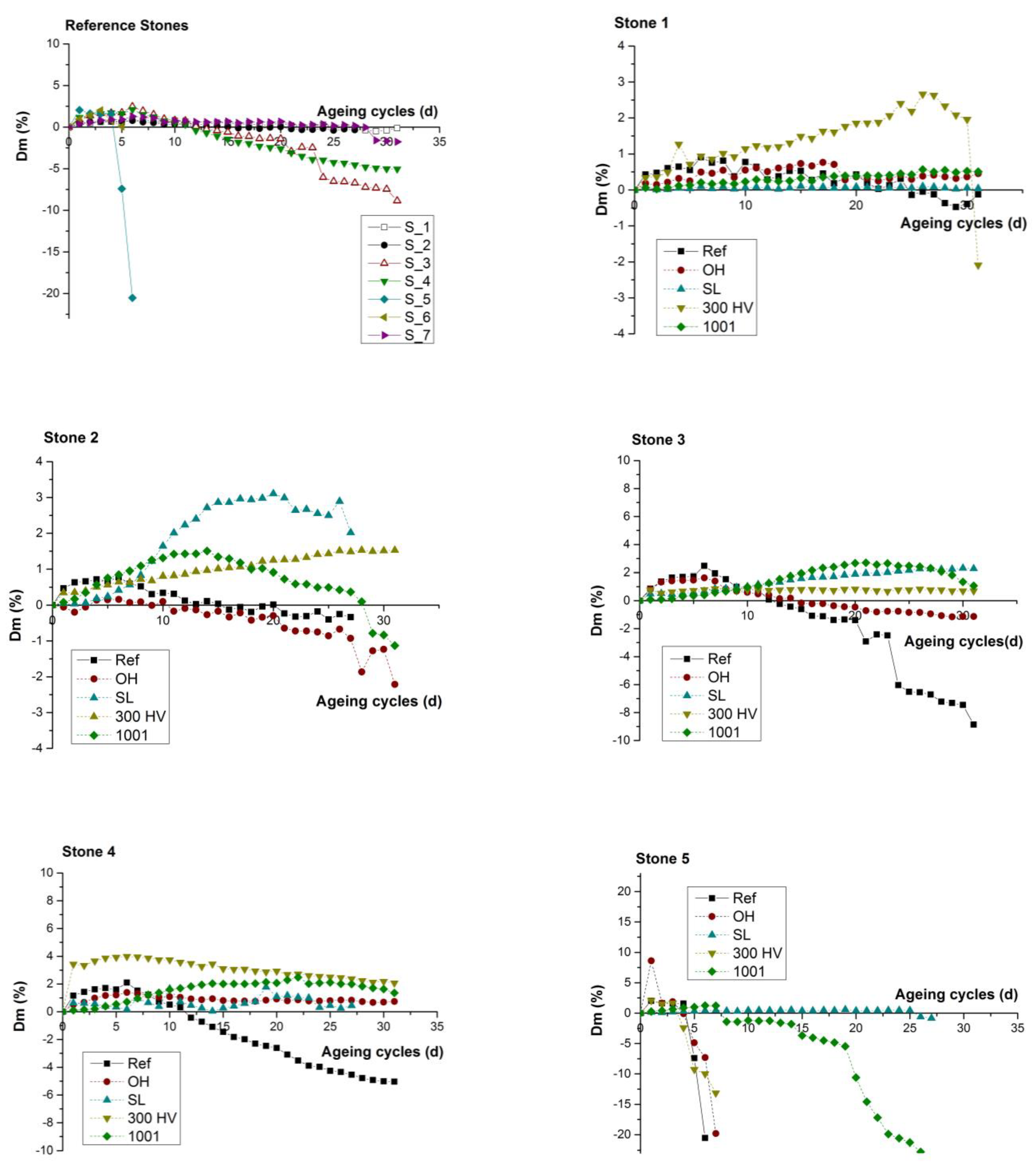

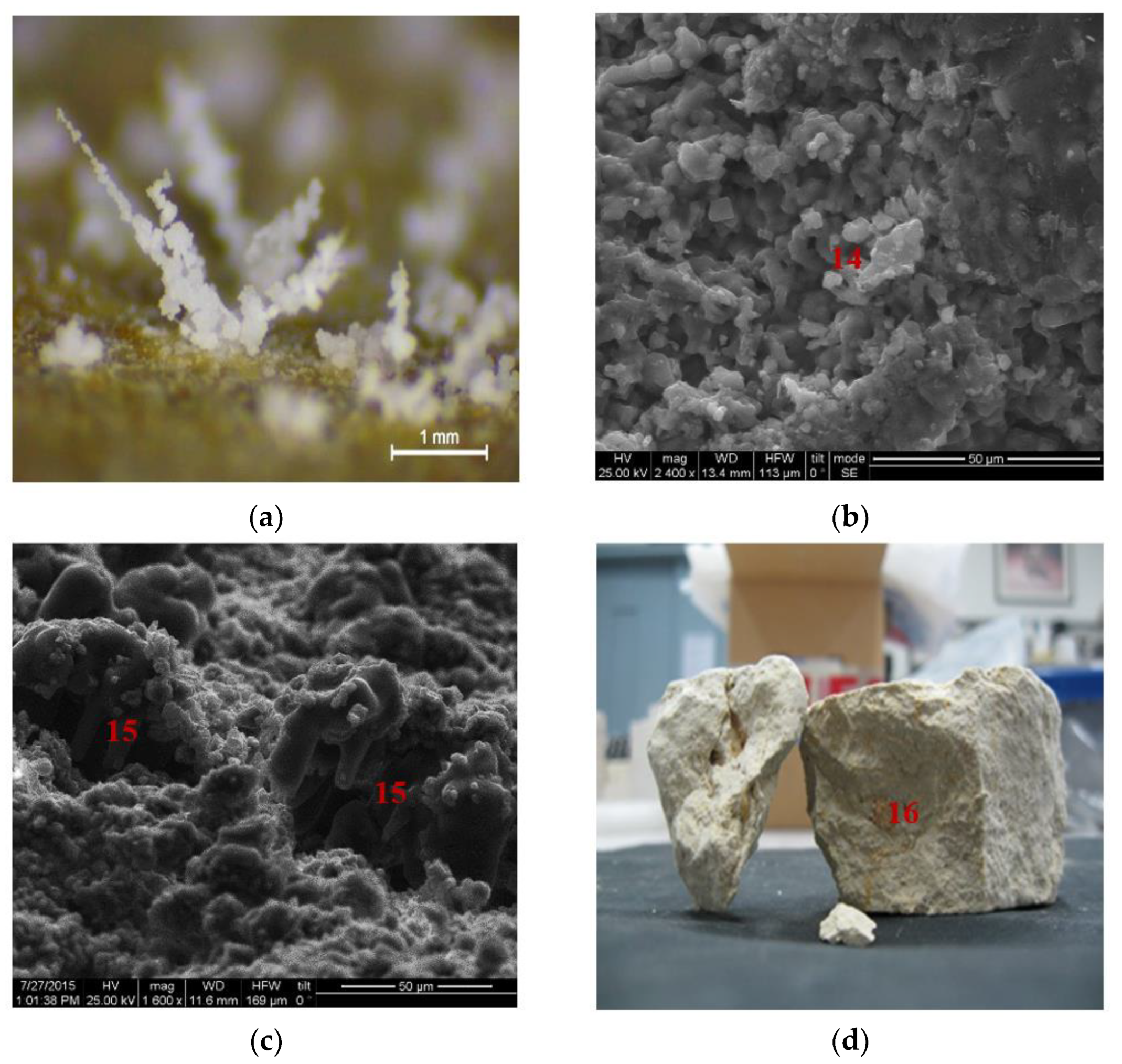
| Samples | Open Porosity % | Mean Pore Radius (μm) | Mode Pore Radius (μm) | ||
|---|---|---|---|---|---|
| High Pressure | Low Pressure | High Pressure | Low Pressure | ||
| S_01 | 19.5 | 0.03 | 0.03 | 0.002 | - |
| S_02 | 22.2 | 0.04 | 50.35 | 0.02 | 5.35 |
| S_03 | 22.7 | 0.09 | 23.35 | 0.024 | 5.36 |
| S_04 | 25.6 | 0.05 | 14.63 | 0.003 | 5.35 |
| S_05 | 37.9 | 0.08 | 57.75 | 0.011 | 7.078 |
| S_06 | 22.2 | 0.08 | 47.11 | 0.015 | 6.313 |
| S_07 | 29.7 | 0.03 | 13.58 | 0.002 | 5.340 |
| Samples | Capillary Water Absorption Coefficient (Acap) (kg/m2 s0.5) | Conducti-vity (mS/cm) | 3 Point Bending Strength (Mpa) | Compressive Strength (MPa) | |
| S_01 | 0.02 | 3.5 | 12 | 62.1 | |
| S_02 | 0.09 | 4.4 | 1.8 | 32.8 | |
| S_03 | 0.11 | 1.5 | 5.5 | 29 | |
| S_04 | 0.13 | 0.8 | 4 | 18.9 | |
| S_05 | 0.07 | 0.4 | - | 5.7 | |
| S_06 | 0.07 | 0.8 | 3.8 | 14.6 | |
| S_07 | 0.04 | - | 5.4 | 46.5 | |
Disclaimer/Publisher’s Note: The statements, opinions and data contained in all publications are solely those of the individual author(s) and contributor(s) and not of MDPI and/or the editor(s). MDPI and/or the editor(s) disclaim responsibility for any injury to people or property resulting from any ideas, methods, instructions or products referred to in the content. |
© 2023 by the authors. Licensee MDPI, Basel, Switzerland. This article is an open access article distributed under the terms and conditions of the Creative Commons Attribution (CC BY) license (https://creativecommons.org/licenses/by/4.0/).
Share and Cite
Michalopoulou, A.; Markantonis, I.; Vlachogiannis, D.; Sfetsos, A.; Kilikoglou, V.; Karatasios, I. Weathering Mechanisms of Porous Marl Stones in Coastal Environments and Evaluation of Conservation Treatments as Potential Adaptation Action for Facing Climate Change Impact. Buildings 2023, 13, 198. https://doi.org/10.3390/buildings13010198
Michalopoulou A, Markantonis I, Vlachogiannis D, Sfetsos A, Kilikoglou V, Karatasios I. Weathering Mechanisms of Porous Marl Stones in Coastal Environments and Evaluation of Conservation Treatments as Potential Adaptation Action for Facing Climate Change Impact. Buildings. 2023; 13(1):198. https://doi.org/10.3390/buildings13010198
Chicago/Turabian StyleMichalopoulou, Anastasia, Iason Markantonis, Diamando Vlachogiannis, Athanasios Sfetsos, Vassilis Kilikoglou, and Ioannis Karatasios. 2023. "Weathering Mechanisms of Porous Marl Stones in Coastal Environments and Evaluation of Conservation Treatments as Potential Adaptation Action for Facing Climate Change Impact" Buildings 13, no. 1: 198. https://doi.org/10.3390/buildings13010198






